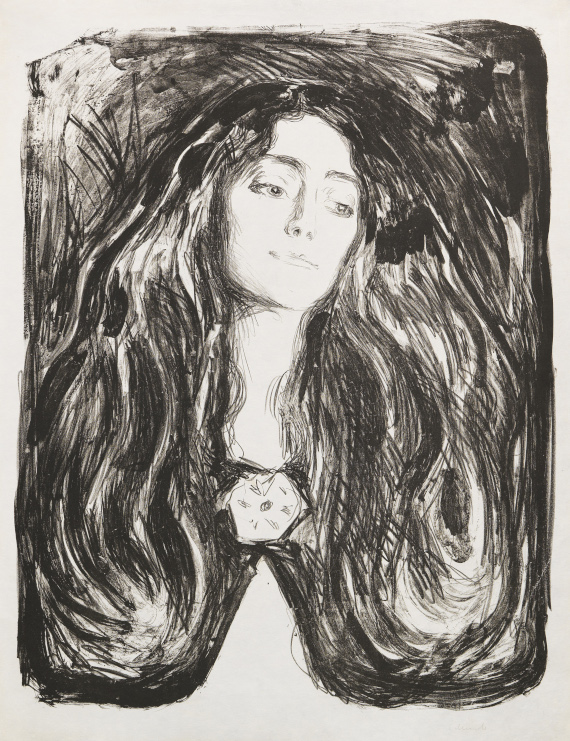1
Edvard Munch
Die Brosche. Eva Mudocci, 1903.
Lithograph
Estimate:
€ 60,000 / $ 70,800 Sold:
€ 196,850 / $ 232,283 (incl. surcharge)
Die Brosche. Eva Mudocci. 1903.
Lithograph.
Woll 244 I, 2 (of V). Schiefler 212. Signed. On Japon. 60.4 x 46.7 cm (23.7 x 18.3 in). Sheet: 66,7 x 51,2 cm (26,3 x 20,2 in).
• Fascinating interplay of an enormous subtlety and a frenetic expressiveness.
• Hardly any other artist created such expressive prints as Edvard Munch.
• The violinist Eva Mudocci inspired the artist to make a lithograph characterized by an unmistakable presence.
• Among Munch's predominantly black prints, "The Brooch. Eva Mudocci" is the most sought-after one on the international auction market (source: artprice.com).
PROVENANCE: Carus Gallery, New York.
Private collection Hamburg (acquired from the above around 45 years ago, ever since family-owned).
Lithograph.
Woll 244 I, 2 (of V). Schiefler 212. Signed. On Japon. 60.4 x 46.7 cm (23.7 x 18.3 in). Sheet: 66,7 x 51,2 cm (26,3 x 20,2 in).
• Fascinating interplay of an enormous subtlety and a frenetic expressiveness.
• Hardly any other artist created such expressive prints as Edvard Munch.
• The violinist Eva Mudocci inspired the artist to make a lithograph characterized by an unmistakable presence.
• Among Munch's predominantly black prints, "The Brooch. Eva Mudocci" is the most sought-after one on the international auction market (source: artprice.com).
PROVENANCE: Carus Gallery, New York.
Private collection Hamburg (acquired from the above around 45 years ago, ever since family-owned).
"It is incredible that something as innocent as painting can create such an uproar." (Edvard Munch, quoted after: Corinna Höper, Edvard Munch in Stuttgart. Vom ersten Kuss bis zum Tod, Munich 2013, p. 12) - these words by Edvard Munch about painting can also be applied to his lithograph portrait of Eva Mudocci (1883–1953). With her eyes lowered, her chin raised and her hair spread out and seemingly in motion, is how he portrayed the famous violinist. A portrait that seems to vibrate with her untamed expressiveness. The lithography technique offered Munch the necessary creative freedom to transform her appearance into something highly expressive: By juxtaposing the finely sketched, expressive facial features and the dynamic, roughly modeled hair, the artist gave this portrait an efficacy that one can hardly elude.
From 1902, the depicted Eva Mudocci performed together with the Danish pianist Bella Edwards (1866–1954) and met Munch in Paris in 1903, the year our lithograph was created. She fell in love with the artist and inspired him to create several paintings, of which she reports: "He wanted to paint me a perfect portrait, but every time he started to paint an oil painting he destroyed it because he wasn't happy with it." (Eva Mudocci, quoted from: Corinna Höper, Edvard Munch in Stuttgart.Vom ersten Kuss bis zum Tod , Munich 2013, p. 81). In printmaking, Munch apparently succeeded in what he couldn’t realize in oil painting. He made three Mudocci lithographs, among them the "Violin Concerto", also from 1903, which shows her performing with Bella Edwards. With its enormous expressiveness, the brilliant individual portrait with the brooch in the center is one of Edvard Munch's most important prints.
With her iconic presence, the depiction of the violinist became well-known and was adopted by Andy Warhol in the 1980s: In his series "After Munch", he also included the portrait of Eva Mudocci and transformed the artist's unique creation into a dazzling pop art silkscreen. Without depriving the depiction of its fundamental character, he modified it and added further fascinating accents to the outstanding work of the pioneering Norwegian artist. [AM]
From 1902, the depicted Eva Mudocci performed together with the Danish pianist Bella Edwards (1866–1954) and met Munch in Paris in 1903, the year our lithograph was created. She fell in love with the artist and inspired him to create several paintings, of which she reports: "He wanted to paint me a perfect portrait, but every time he started to paint an oil painting he destroyed it because he wasn't happy with it." (Eva Mudocci, quoted from: Corinna Höper, Edvard Munch in Stuttgart.Vom ersten Kuss bis zum Tod , Munich 2013, p. 81). In printmaking, Munch apparently succeeded in what he couldn’t realize in oil painting. He made three Mudocci lithographs, among them the "Violin Concerto", also from 1903, which shows her performing with Bella Edwards. With its enormous expressiveness, the brilliant individual portrait with the brooch in the center is one of Edvard Munch's most important prints.
With her iconic presence, the depiction of the violinist became well-known and was adopted by Andy Warhol in the 1980s: In his series "After Munch", he also included the portrait of Eva Mudocci and transformed the artist's unique creation into a dazzling pop art silkscreen. Without depriving the depiction of its fundamental character, he modified it and added further fascinating accents to the outstanding work of the pioneering Norwegian artist. [AM]
1
Edvard Munch
Die Brosche. Eva Mudocci, 1903.
Lithograph
Estimate:
€ 60,000 / $ 70,800 Sold:
€ 196,850 / $ 232,283 (incl. surcharge)
Headquarters
Joseph-Wild-Str. 18
81829 Munich
Phone: +49 89 55 244-0
Fax: +49 89 55 244-177
info@kettererkunst.de
Louisa von Saucken / Undine Schleifer
Holstenwall 5
20355 Hamburg
Phone: +49 40 37 49 61-0
Fax: +49 40 37 49 61-66
infohamburg@kettererkunst.de
Dr. Simone Wiechers / Nane Schlage
Fasanenstr. 70
10719 Berlin
Phone: +49 30 88 67 53-63
Fax: +49 30 88 67 56-43
infoberlin@kettererkunst.de
Cordula Lichtenberg
Gertrudenstraße 24-28
50667 Cologne
Phone: +49 221 510 908-15
infokoeln@kettererkunst.de
Hessen
Rhineland-Palatinate
Miriam Heß
Phone: +49 62 21 58 80-038
Fax: +49 62 21 58 80-595
infoheidelberg@kettererkunst.de
We will inform you in time.




 Lot 1
Lot 1 
